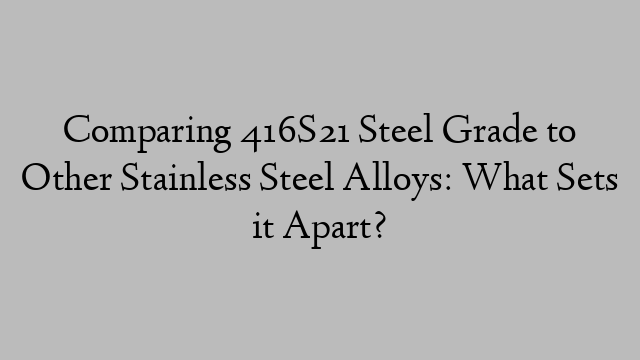Address
304 North Cardinal St.
Dorchester Center, MA 02124
Work Hours
Monday to Friday: 7AM - 7PM
Weekend: 10AM - 5PM
Address
304 North Cardinal St.
Dorchester Center, MA 02124
Work Hours
Monday to Friday: 7AM - 7PM
Weekend: 10AM - 5PM

Stainless steel is a versatile and widely used material in a variety of industries, including construction, automotive, and manufacturing. There are numerous grades of stainless steel available, each with its own unique properties and characteristics. One such grade is 416S21, which is known for its excellent machinability and corrosion resistance. In this article, we will compare 416S21 to other stainless steel alloys and explore what sets it apart.
416S21 is a martensitic stainless steel grade with high levels of sulfur, which contributes to its excellent machinability. This makes it a popular choice for applications where intricate and precise machining is required, such as in the production of components for the automotive and aerospace industries. In addition to its machinability, 416S21 also offers good corrosion resistance and is suitable for use in mild industrial and marine environments.
One of the most widely used stainless steel grades is 304, which is known for its excellent corrosion resistance and formability. While 416S21 also offers good corrosion resistance, it is not as resistant to corrosion as 304. However, 416S21 outperforms 304 in terms of machinability, making it a preferred choice for applications where machining is a critical factor.
Another popular stainless steel grade is 316, which is known for its superior corrosion resistance, especially in harsh and corrosive environments. While 416S21 is not as corrosion-resistant as 316, it still offers good corrosion resistance in mild industrial and marine environments. Additionally, 416S21 has better machinability compared to 316, making it a better choice for applications where machining is a priority.
Compared to other martensitic stainless steel grades such as 410 and 420, 416S21 offers similar levels of corrosion resistance but stands out for its superior machinability. This makes it a preferred choice for applications where both corrosion resistance and machinability are important factors.
In conclusion, while 416S21 may not offer the same level of corrosion resistance as some of the more popular stainless steel grades such as 304 and 316, it excels in terms of machinability. This makes it a preferred choice for applications where precise machining is a priority. By understanding the unique properties of 416S21 and comparing it to other stainless steel alloys, manufacturers can make informed decisions about the best grade to use for their specific applications.